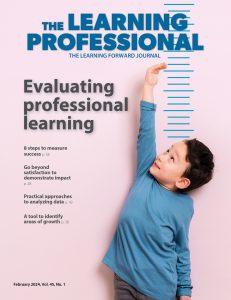What can educators learn from Star Wars? You do not have to inhabit a galaxy far, far away to learn lessons about effective professional learning. In fact, the most effective professional learning occurs within your own educational sphere, so here are six lessons to transform learning in your own universe.
Lesson 1. Have a vision.
“You will find that many of the truths we cling to depend greatly on our own point of view.” — Obi-Wan Kenobi
Luke Skywalker dreams of becoming a Jedi knight. Whether on a faraway planet or in a school, a dream begins with a vision of success.
Know where you are going. A shared vision is more likely to be realized when team members focus on the question, “What will it look like when we achieve the desired outcomes?” Learning goals for students and educators inform conversations about what classrooms should look like.
My experience has been that teams often launch into discussions about learning activities without first creating a plan for change, including measureable goals that will take them from where they currently are to where they want to be. Having a vision for what success looks like and a detailed plan for achieving the desired outcomes are essential for the journey.
Lesson 2. Invest in learning.
“Training to be a Jedi will not be an easy challenge.” — Qui-Gon Jinn
Luke is warned that the right path is not always the easy path and begins intensive training under Yoda. When Luke confronts Darth Vader before completing his training, he fails. Only when Luke fully completes his Jedi training is he able to successfully balance the light and dark sides of the force.
Investing in refining your knowledge, skills, and instructional practice is key to increasing student achievement. Learning takes deliberate, focused, consistent practice.
Have you ever attended training on a new instructional program or practice, then were expected to implement it without classroom support? You leave with the responsibility for the implementation, but without the resources needed. Imagine if you had opportunities to develop background knowledge, collaborate with peers, practice the new strategies in the classroom, and receive coaching and feedback. What impact would this learning have on student outcomes?
Killion describes the learning-focused feedback process as a key component in continuous learning (2015). Dweck emphasizes having a growth mindset and the importance of focused, consistent practice (2007). Research by Joyce and Showers provides convincing evidence of the impact of application, practice, coaching, and feedback on learning (2002).
Just as Yoda’s training transformed Luke’s discipline and skills, investing in your own learning is the pathway to improved instructional practice and positive change for students.
Lesson 3. Collaborate and Connect.
“The Force is what gives a Jedi his power. It’s an energy field created by all living things. It surrounds us and penetrates us. It binds the galaxy together.” — Obi-Wan Kenobi
Star Wars teaches us that we can tap into something more powerful than ourselves. Collaboration unites interplanetary forces and the Dark Side is defeated. Luke had Han Solo, Princess Leia, Obi-Wan, C3P0, Chewbacca, and R2D2. Rey had Finn and BB8. As a collaborative team, their collective force was more powerful than their individual powers.
Intentional collaborative learning is a powerful force. It can promote the implementation of new practices with fidelity and accelerate student achievement. Hattie’s recent report on what works in education emphasizes the potential of collaborative expertise to enhance student outcomes (2015). Hattie highlights the importance of harnessing and sharing this collaborative expertise within schools to create cultures that support the assessment of instructional practice and impact on student learning.
Collaboration also appeals to the desire in each person to connect with others and with something bigger. Star Wars sums up this theme with the simple words, learn to use the Force.
Lesson 4. Observe. Assess. Act.
Anakin Skywalker: “How did you know they wouldn’t just attack us?”
Obi-Wan Kenobi: “Because I make observations while you think with your light saber.”
In Star Wars, we know when something ominous is about to happen because of the foreboding music or the distinctive breathing of Darth Vader or Kylo Ren. The Jedi describe it as a sense of “disturbance in the Force.” As educators, we must rely on student data and their work to detect this “disturbance” in learning progress.
So what are the next steps after the professional learning has been applied and formative and summative classroom data, including observations, have been gathered? Examine the data, assess how the new strategies worked, and share feedback about progress. Discuss successes, challenges and fidelity to the goals. Collaborate on changes then implement them. Refine your practice. Continually assess progress. These are the essential next steps that help teams “think beyond the light saber.”
Lesson 5. Find your Yoda.
“All mentors have a way of seeing more of our faults than we would like. It’s the only way we grow.” — Padme
When Luke first meets Yoda, he dismisses the creature as bothersome to his mission of finding a Jedi master. Luke eventually learns that the diminutive Yoda is actually the Jedi master he seeks.
My first mentor in education was also like Yoda, diminutive and very wise. Mrs. Winter guided me through the turbulent first years of teaching. Since then, I have had mentors who were peers, coaches, colleagues, and external experts. Their informed voices influenced my thinking and practice through feedback and continuous support.
Maz Kanata, a Yoda-like mentor in The Force Awakens, counsels, “ I have lived long enough to see the same eyes in different people.” Maz had the gift of seeing souls. Such mentors are like mystics. They perceive our potential before we know the possibilities. Seek mentors on your journey and learn from them. Find your Yoda….or Maz.
Lesson 6. Share the lead.
“Do or do not… there is no try.” — Yoda
In The Force Awakens, Finn is initially conflicted about assuming a leadership role. Caring about something larger than himself propels him into leadership. The Star Wars characters found the Force and their collective leadership restored power to the Republic.
Shared leadership is possible in your setting. A single leader can not change a school. When authority and decision making are shared, each person has a voice and a choice. By making clear choices to ”do or not to do,” and putting power behind those choices, you can lead successfully.
These six lessons from Star Wars can be transformational. Find the Force and learn to use it. Once you find the Force . . . your students will find it also.
Let the Force be with you.
References
Dweck, C. (2007). Mindset: The new psychology of success. New York, NY: Ballantine Books
Hattie, J. (2015). What works best in education: the politics of collaborative expertise. London: Pearson.
Joyce, B. and Showers, B. (2002). Student achievement through staff development. Alexandria, VA. ASCD
Killion, J. (2015) The feedback process: Transforming feedback for professional learning. Oxford, OH: Learning Forward







